《有机化学》课程教学课件(Organic Chemistry, Alex Jonathan Roche lecture notes Rutgers The State University NJ, wade 8th)Chapter 01 Introduction
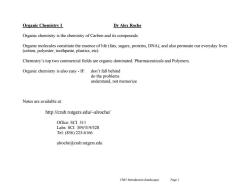
Organic Chemistry I Dr Alex Roche Organic chemistry is the chemistry of Carbon and its compounds. Organic molecules constitute the essence of life(fats,sugars,proteins,DNA),and also permeate our everyday lives (cotton,polyester,toothpaste,plastics,etc). Chemistry's top two commercial fields are organic dominated:Pharmaceuticals and Polymers. Organic chemistry is also easy-IF:don't fall behind do the problems understand,not memorize Notes are available at: http://crab.rutgers.edu/-alroche/ Office:SCI 311 Labs:SCI309/319/328 Tel:(856)225-6166 alroche@crab.rutgers.edu Chol Introduction (landscape) Page I
Ch01 Introduction (landscape) Page 1 Organic Chemistry I Dr Alex Roche Organic chemistry is the chemistry of Carbon and its compounds. Organic molecules constitute the essence of life (fats, sugars, proteins, DNA), and also permeate our everyday lives (cotton, polyester, toothpaste, plastics, etc). Chemistry’s top two commercial fields are organic dominated: Pharmaceuticals and Polymers. Organic chemistry is also easy - IF: don’t fall behind do the problems understand, not memorize Notes are available at: http://crab.rutgers.edu/~alroche/ Office: SCI 311 Labs: SCI 309/319/328 Tel: (856) 225-6166 alroche@crab.rutgers.edu
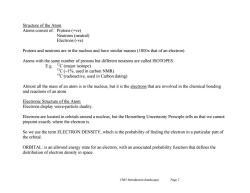
Structure of the Atom Atoms consist of:Protons (+ve) Neutrons(neutral) Electrons (-ve) Protons and neutrons are in the nucleus and have similar masses(1800x that of an electron). Atoms with the same number of protons but different neutrons are called ISOTOPES. E.g.C(major isotope) 1C(~1%,used in carbon NMR) C(radioactive,used in Carbon dating) Almost all the mass of an atom is in the nucleus,but it is the electrons that are involved in the chemical bonding and reactions of an atom. Electronic Structure of the Atom Electrons display wave-particle duality. Electrons are located in orbitals around a nucleus,but the Heisenberg Uncertainty Principle tells us that we cannot pinpoint exactly where the electron is. So we use the term ELECTRON DENSITY,which is the probability of finding the electron in a particular part of the orbital. ORBITAL:is an allowed energy state for an electron,with an associated probability function that defines the distribution of electron density in space. Chol Introduction (landscape) Page 2
Ch01 Introduction (landscape) Page 2 Structure of the Atom Atoms consist of: Protons (+ve) Neutrons (neutral) Electrons (-ve) Protons and neutrons are in the nucleus and have similar masses (1800x that of an electron). Atoms with the same number of protons but different neutrons are called ISOTOPES. E.g. 12C (major isotope) 13C (~1%, used in carbon NMR) 14C (radioactive, used in Carbon dating) Almost all the mass of an atom is in the nucleus, but it is the electrons that are involved in the chemical bonding and reactions of an atom. Electronic Structure of the Atom Electrons display wave-particle duality. Electrons are located in orbitals around a nucleus, but the Heisenberg Uncertainty Principle tells us that we cannot pinpoint exactly where the electron is. So we use the term ELECTRON DENSITY, which is the probability of finding the electron in a particular part of the orbital. ORBITAL: is an allowed energy state for an electron, with an associated probability function that defines the distribution of electron density in space
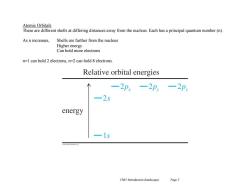
Atomic Orbitals These are different shells at differing distances away from the nucleus.Each has a principal quantum number(n). As n increases, Shells are further from the nucleus Higher energy Can hold more electrons n=1 can hold 2 electrons,n=2 can hold 8 electrons. Relative orbital energies 一2p.一2p,一2p 25 energy 1g Chol Introduction (landscape) Page3
Ch01 Introduction (landscape) Page 3 Atomic Orbitals These are different shells at differing distances away from the nucleus. Each has a principal quantum number (n). As n increases, Shells are further from the nucleus Higher energy Can hold more electrons n=1 can hold 2 electrons, n=2 can hold 8 electrons
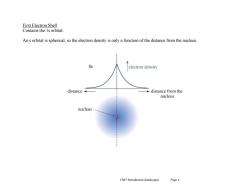
First Electron Shell Contains the 1s orbital. An s orbital is spherical,so the electron density is only a function of the distance from the nucleus. 1s electron density distance distance from the nucleus nucleus Chol Introduction (landscape) Page 4
Ch01 Introduction (landscape) Page 4 First Electron Shell Contains the 1s orbital. An s orbital is spherical, so the electron density is only a function of the distance from the nucleus
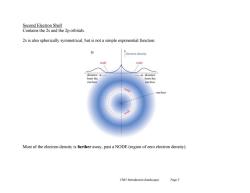
Second Electron Shell Contains the 2s and the 2p orbitals 2s is also spherically symmetrical,but is not a simple exponential function 2☒ electron density node node distance -→distance from the from the nucleu nucleus node nucleus node Most of the electron density is further away,past a NODE(region of zero electron density). Chol Introduction (landscape) Page 5
Ch01 Introduction (landscape) Page 5 Second Electron Shell Contains the 2s and the 2p orbitals. 2s is also spherically symmetrical, but is not a simple exponential function. Most of the electron density is further away, past a NODE (region of zero electron density)
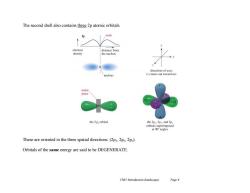
The second shell also contains three 2p atomic orbitals. 2p node electron distance from density the nucleus directions of axes nucleus (z comes out toward us) nodal plane the 2p,orbital the 2p 2py,and 2p. orbitals s rimposed at90°angles These are oriented in the three spatial directions.(2ps,2py,2pz). Orbitals of the same energy are said to be DEGENERATE. Chol Introduction (landscape) Page 6
Ch01 Introduction (landscape) Page 6 The second shell also contains three 2p atomic orbitals. These are oriented in the three spatial directions. (2px, 2py, 2pz). Orbitals of the same energy are said to be DEGENERATE
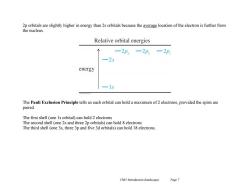
2p orbitals are slightly higher in energy than 2s orbitals because the average location of the electron is further from the nucleus. Relative orbital energies -2Px -2p,-2p -25 energy 一1 The Pauli Exclusion Principle tells us each orbital can hold a maximum of 2 electrons,provided the spins are paired. The first shell (one 1s orbital)can hold 2 electrons The second shell (one 2s and three 2p orbitals)can hold 8 electrons The third shell (one 3s.three 3p and five 3d orbitals)can hold 18 electrons. Chol Introduction (landscape) Page 7
Ch01 Introduction (landscape) Page 7 2p orbitals are slightly higher in energy than 2s orbitals because the average location of the electron is further from the nucleus. The Pauli Exclusion Principle tells us each orbital can hold a maximum of 2 electrons, provided the spins are paired. The first shell (one 1s orbital) can hold 2 electrons The second shell (one 2s and three 2p orbitals) can hold 8 electrons The third shell (one 3s, three 3p and five 3d orbitals) can hold 18 electrons
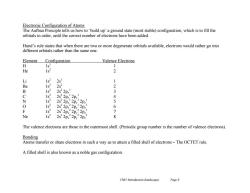
Electronic Configuration of Atoms The Aufbau Principle tells us how to 'build up'a ground state(most stable)configuration,which is to fill the orbitals in order,until the correct number of electrons have been added. Hund's rule states that when there are two or more degenerate orbitals available,electrons would rather go into different orbitals rather than the same one. Element Configuration Valence Electrons H ls' 1 He 2 Li 1s2 2 1 Be 1s 2s2 2 B 1s? 2s22px 3 1s 2s2 4 N 1s 2s2 5 0 1s? 2s2 2px 2py,2pz 6 F 1s 2s2 2px 2Py 7 Ne 1s2 2s22px22p,22p2 8 The valence electrons are those in the outermost shell.(Periodic group number is the number of valence electrons). Bonding Atoms transfer or share electrons in such a way as to attain a filled shell of electrons-The OCTET rule A filled shell is also known as a noble gas configuration. Chol Introduction (landscape) Page 8
Ch01 Introduction (landscape) Page 8 Electronic Configuration of Atoms The Aufbau Principle tells us how to ‘build up’ a ground state (most stable) configuration, which is to fill the orbitals in order, until the correct number of electrons have been added. Hund’s rule states that when there are two or more degenerate orbitals available, electrons would rather go into different orbitals rather than the same one. Element Configuration Valence Electrons H 1s1 1 He 1s2 2 Li 1s2 2s1 1 Be 1s2 2s2 2 B 1s2 2s2 2px 1 3 C 1s2 2s2 2px 1 2py 1 4 N 1s2 2s2 2px 1 2py 1 2pz 1 5 O 1s2 2s2 2px 2 2py 1 2pz 1 6 F 1s2 2s2 2px 2 2py 2 2pz 1 7 Ne 1s2 2s2 2px 2 2py 2 2pz 2 8 The valence electrons are those in the outermost shell. (Periodic group number is the number of valence electrons). Bonding Atoms transfer or share electrons in such a way as to attain a filled shell of electrons – The OCTET rule. A filled shell is also known as a noble gas configuration
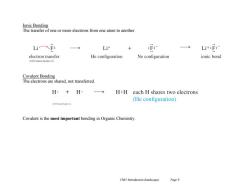
Ionic Bonding The transfer of one or more electrons from one atom to another Li一f: Li+ Li+:F: electron transfer He configuration Ne configuration ionic bond Covalent Bonding The electrons are shared,not transferred. H·+H H:H each H shares two electrons (He configuration) o动13 Covalent is the most important bonding in Organic Chemistry. Chol Introduction (landscape) Page 9
Ch01 Introduction (landscape) Page 9 Ionic Bonding The transfer of one or more electrons from one atom to another. Covalent Bonding The electrons are shared, not transferred. Covalent is the most important bonding in Organic Chemistry
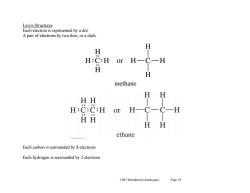
Lewis Structures Each electron is represented by a dot. A pair of electrons by two dots,or a dash. H H H:C:H or H H ⅱ H methane H H HH H:C:C:H or H一 HH H H ethane Each carbon is surrounded by 8 electrons Each hydrogen is surrounded by 2 electrons. Chol Introduction (landscape) Page 10
Ch01 Introduction (landscape) Page 10 Lewis Structures Each electron is represented by a dot. A pair of electrons by two dots, or a dash. Each carbon is surrounded by 8 electrons Each hydrogen is surrounded by 2 electrons
按次数下载不扣除下载券;
注册用户24小时内重复下载只扣除一次;
顺序:VIP每日次数-->可用次数-->下载券;
- 《有机化学》课程PPT教学课件(Organic Chemistry with Biological Applications, 3th Edition, John McMurry, 2016)Chapter 27 Synthetic Polymers.ppt
- 《有机化学》课程PPT教学课件(Organic Chemistry with Biological Applications, 3th Edition, John McMurry, 2016)Chapter 26 Orbitals and Organic Chemistry - Pericyclic Reactions.ppt
- 《有机化学》课程PPT教学课件(Organic Chemistry with Biological Applications, 3th Edition, John McMurry, 2016)Chapter 25 Secondary Metabolites - An Introduction to Natural Products Chemistry.ppt
- 《有机化学》课程PPT教学课件(Organic Chemistry with Biological Applications, 3th Edition, John McMurry, 2016)Chapter 24 Biomolecules - Nucleic Acids and Their Metabolism.ppt
- 《有机化学》课程PPT教学课件(Organic Chemistry with Biological Applications, 3th Edition, John McMurry, 2016)Chapter 23 Biomolecules - Lipids and Their Metabolism.ppt
- 《有机化学》课程PPT教学课件(Organic Chemistry with Biological Applications, 3th Edition, John McMurry, 2016)Chapter 22 Carbohydrate Metabolism.ppt
- 《有机化学》课程PPT教学课件(Organic Chemistry with Biological Applications, 3th Edition, John McMurry, 2016)Chapter 21 Biomolecules - Carbohydrates.ppt
- 《有机化学》课程PPT教学课件(Organic Chemistry with Biological Applications, 3th Edition, John McMurry, 2016)Chapter 20 Amino Acid Metabolism.ppt
- 《有机化学》课程PPT教学课件(Organic Chemistry with Biological Applications, 3th Edition, John McMurry, 2016)Chapter 19 Biomolecules - Amino Acids, Peptides, and Proteins.ppt
- 《有机化学》课程PPT教学课件(Organic Chemistry with Biological Applications, 3th Edition, John McMurry, 2016)Chapter 18 Amines and Heterocycles.ppt
- 《有机化学》课程PPT教学课件(Organic Chemistry with Biological Applications, 3th Edition, John McMurry, 2016)Chapter 17 Carbonyl Alpha-Substitution and Condensation Reactions.ppt
- 《有机化学》课程PPT教学课件(Organic Chemistry with Biological Applications, 3th Edition, John McMurry, 2016)Chapter 16 Carboxylic Acid Derivatives - Nucleophilic Acyl Substitution Reactions.ppt
- 《有机化学》课程PPT教学课件(Organic Chemistry with Biological Applications, 3th Edition, John McMurry, 2016)Chapter 15 Carboxylic Acids and Nitriles.ppt
- 《有机化学》课程PPT教学课件(Organic Chemistry with Biological Applications, 3th Edition, John McMurry, 2016)Chapter 14 Aldehydes and Ketones - Nucleophilic Additions Reactions.ppt
- 《有机化学》课程PPT教学课件(Organic Chemistry with Biological Applications, 3th Edition, John McMurry, 2016)Chapter 13 Alcohols, Phenols, and Thiols; Ethers and Sulfides.ppt
- 《有机化学》课程PPT教学课件(Organic Chemistry with Biological Applications, 3th Edition, John McMurry, 2016)Chapter 12 Organohalides - Nucleophilic Substitutions and Eliminations.ppt
- 《有机化学》课程PPT教学课件(Organic Chemistry with Biological Applications, 3th Edition, John McMurry, 2016)Chapter 10 Structure Determination - Mass Spectrometry, Infrared Spectroscopy, and Ultraviolet Spectroscopy.ppt
- 《有机化学》课程PPT教学课件(Organic Chemistry with Biological Applications, 3th Edition, John McMurry, 2016)Chapter 11 Structure Determination - Nuclear Magnetic Resonance Spectroscopy.ppt
- 《有机化学》课程PPT教学课件(Organic Chemistry with Biological Applications, 3th Edition, John McMurry, 2016)Chapter 09 Aromatic Compounds.ppt
- 《有机化学》课程PPT教学课件(Organic Chemistry with Biological Applications, 3th Edition, John McMurry, 2016)Chapter 08 Reactions of Alkenes and Alkynes.ppt
- 《有机化学》课程教学课件(Organic Chemistry, Alex Jonathan Roche lecture notes Rutgers The State University NJ, wade 8th)Chapter 02 Structure and Properties.pdf
- 《有机化学》课程教学课件(Organic Chemistry, Alex Jonathan Roche lecture notes Rutgers The State University NJ, wade 8th)Chapter 03 Alkanes.pdf
- 《有机化学》课程教学课件(Organic Chemistry, Alex Jonathan Roche lecture notes Rutgers The State University NJ, wade 8th)Chapter 04 Rates & Kinetics.pdf
- 《有机化学》课程教学课件(Organic Chemistry, Alex Jonathan Roche lecture notes Rutgers The State University NJ, wade 8th)Chapter 05 Stereochemistry.pdf
- 《有机化学》课程教学课件(Organic Chemistry, Alex Jonathan Roche lecture notes Rutgers The State University NJ, wade 8th)Chapter 06 Alkyl Halides.pdf
- 《有机化学》课程教学课件(Organic Chemistry, Alex Jonathan Roche lecture notes Rutgers The State University NJ, wade 8th)Chapter 07 Structure and Synthesis of Alkenes.pdf
- 《有机化学》课程教学课件(Organic Chemistry, Alex Jonathan Roche lecture notes Rutgers The State University NJ, wade 8th)Chapter 08 Reactions of Alkenes.pdf
- 《有机化学》课程教学课件(Organic Chemistry, Alex Jonathan Roche lecture notes Rutgers The State University NJ, wade 8th)Chapter 09 Alkynes.pdf
- 《有机化学》课程教学课件(Organic Chemistry, Alex Jonathan Roche lecture notes Rutgers The State University NJ, wade 8th)Chapter 10 Synthesis and Structure of Alcohols.pdf
- 《有机化学》课程教学课件(Organic Chemistry, Alex Jonathan Roche lecture notes Rutgers The State University NJ, wade 8th)Chapter 11 Reactions of Alcohols.pdf
- 《有机化学》课程教学课件(Organic Chemistry, Alex Jonathan Roche lecture notes Rutgers The State University NJ, wade 8th)Chapter 12 Infrared Spectroscopy and Mass Spectrometry.pdf
- 《有机化学》课程教学课件(Organic Chemistry, Alex Jonathan Roche lecture notes Rutgers The State University NJ, wade 8th)Chapter 13 Nuclear Magnetic Resonance(NMR)Spectroscopy.pdf
- 《有机化学》课程教学课件(Organic Chemistry, Alex Jonathan Roche lecture notes Rutgers The State University NJ, wade 8th)Chapter 14 Ethers and Epoxides.pdf
- 《有机化学》课程教学课件(Organic Chemistry, Alex Jonathan Roche lecture notes Rutgers The State University NJ, wade 8th)Chapter 15 Conjugated Systems.pdf
- 《有机化学》课程教学课件(Organic Chemistry, Alex Jonathan Roche lecture notes Rutgers The State University NJ, wade 8th)Chapter 16 Aromatic Compounds.pdf
- 《有机化学》课程教学课件(Organic Chemistry, Alex Jonathan Roche lecture notes Rutgers The State University NJ, wade 8th)Chapter 17 Reactions of Aromatic Compounds.pdf
- 《有机化学》课程教学课件(Organic Chemistry, Alex Jonathan Roche lecture notes Rutgers The State University NJ, wade 8th)Chapter 18 Ketones and Aldehydes.pdf
- 《有机化学》课程教学课件(Organic Chemistry, Alex Jonathan Roche lecture notes Rutgers The State University NJ, wade 8th)Chapter 19 Amines.pdf
- 《有机化学》课程教学课件(Organic Chemistry, Alex Jonathan Roche lecture notes Rutgers The State University NJ, wade 8th)Chapter 20 Carboxylic Acids.pdf
- 《有机化学》课程教学课件(Organic Chemistry, Alex Jonathan Roche lecture notes Rutgers The State University NJ, wade 8th)Chapter 21 Carboxylic acid Derivatives.pdf
